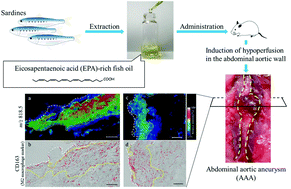Similar distribution of orally administered eicosapentaenoic acid and M2 macrophage marker in the hypoperfusion-induced abdominal aortic aneurysm wall
Abstract
Abdominal aortic aneurysm (AAA) is an aortic disease in which the aortic diameter is ≥3.0 cm; if left untreated, the aortic wall continues to weaken, resulting in progressive dilatation. Effective therapeutic drugs for AAA patients have not been discovered. Eicosapentaenoic acid (EPA) reportedly attenuates the development of AAA in experimental AAA animal models. However, the underlying mechanism of action is still not totally clear. To understand the mechanism, we visualized the distribution of EPA-containing phosphatidylcholine (PC) in the AAA wall by matrix-assisted laser desorption ionization-mass spectrometry imaging. EPA-containing PC was characteristically distributed in the AAA wall, and the positive area for the M2 macrophage marker was significantly higher in the region where EPA-containing PC was highly detected (region 2) than in the region where EPA-containing PC was poorly detected (region 1). The M1 macrophage marker levels were not different between regions 1 and 2. A comparative observation showed a similar distribution of the M2 macrophage marker and EPA-containing PC. These data suggest the preferential incorporation of EPA into M2 macrophages. Positive areas for matrix metalloproteinase 2 and malondialdehyde in region 2 were significantly lower than those in region 1. The reported suppressive effect of EPA on the development of AAA may be partly attributed to the increased anti-inflammatory property of M2 macrophages.



 Please wait while we load your content...
Please wait while we load your content...